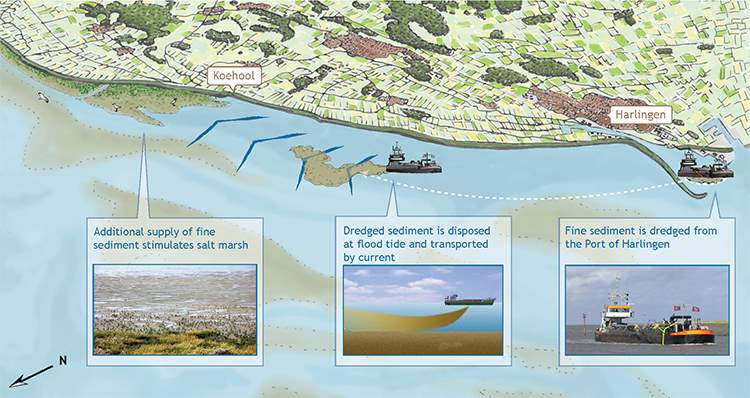Mud motor Koehoal
Harbours are prone to accumulation of mud on the bottom and need to be dredged. What if we could optimise dredging and disposal strategies such that we can facilitate natural development of important habitat areas? Find out more in our Mud Motor project, recently applied in Harlingen and Koehoal.
MUD MOTOR PILOT IN DUTCH HARBOUR
In September 2016, Royal HaskoningDHV started together with the municipality of Harlingen (NL), nature organisation It Fryske Gea, Arcadis, Deltares and EcoShape a novel pilot project financed by the Waddenfonds. Mud, dredged from the harbour of Harlingen, was disposed in front of a salt marsh to facilitate further salt marsh growth. This ‘Mud Motor’ reduces the need for future dredging, because the sediment is trapped in the marshes, it is no longer transported back to the port. The increase in tidal marsh elevation is beneficial for coastal protection and for ecology, because it prevents drowning of marshes due to sea level rise.
DREDGED MATERIAL TREATED AS WASTE
To maintain navigability in the harbour of Harlingen, a total of 1.3 million cubic metres of mud needs to be dredged every year. Dredged material is often treated as useless material and disposed further of the coast. However, salt marshes are naturally built from mud. If we understand the natural dynamics of salt marsh growth, tides, waves and mud transport, we can use the dredged material in a beneficial way for the growth of salt marshes.

Dredging fine sediments is necessary to maintain harbours. Here, dredged mud is used in a smart way, facilitating salt marsh growth.
FROM DREDGED MATERIAL TO NATURE BASED SOLUTION
In the Mud Motor project, dredged mud from the harbour of Harlingen, was disposed in a channel in front of a salt marsh to facilitate further salt marsh growth. The mud is transported towards the salt marsh by natural flow. Such a ‘Mud Motor’ has the following beneficial effects:
-
The dredging demand reduces as sediment is trapped in the marshes and not transported back to the port;
-
The quality of the ecosystem is improved by growth of the marsh;
-
The flood safety increases, because the additional salt marsh height dampens the waves during stormy conditions.
Monitoring this first pilot and improving knowledge about both natural processes as social and legal aspects is necessary to optimise the design of the Mud Motor. Royal HaskoningDHV was part of the team that monitored and investigated the pilot and shared knowledge about this experiment.
SYNERGY BETWEEN HARBOURS AND NATURE
The first results from the Mud Motor look promising for further implementation. The lessons learned in this pilot project can be used to further optimise the design and implementation. The Mud Motor is an example of a Nature-Based Solution, which can now be applied in harbours worldwide to create a synergy between harbour maintenance and nature development.
Petra Dankers
Senior Project Leader & Advisor Morphology and Eco-engineering
Nijmegen, NL
+31 88 348 68 69
+31 6 11 91 41 63
petra.dankers@rhdhv.com